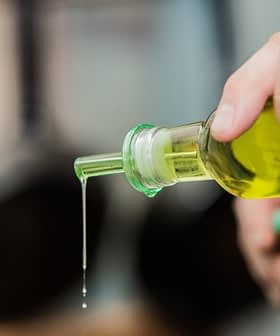The olive provides a culinary landscape in which an appreciation of the unique chemical nature is a key to real understanding. The chemical structure of the natural biomolecules of the olive can be related to the development of the characteristic color, taste, and smell of the oils. These unique biomolecules give rise to the identification of olive oil as the healthy oil.
The growth in the global market for olive oil and the regional expansion of productivity have necessitated the drafting of new international standards to protect the consumer and prevent fraudulent oils from getting to market.
The body of the olive oil lies in its component triglyerides, which are fatty acids bound to glycerin. Free fatty acids (FFAs) are natural degradation products of these triglycerides. The major FFA in olive oil is Oleic acid (named after the Oleo europa tree). While it can be very hard to taste the difference between olive oils of different FFA content due to the fatty acids themselves, a high acid content is usually associated with other negative characteristics such as improper handling or storage of the olives prior to pressing. The cost of the oil will be determined in part by whether it is classified as an extra virgin (less than 0.8% FFA) or virgin (less than 1.5% FFA).
The standard analysis for free fatty acids (FFA) is a titration with a standard base commonly known as lye (sodium hydroxide-NaOH). In a professional analysis lab, the FFAs are extracted from the oil using a mixed solvent of equal parts ethanol and diethyl ether, the fumes of which are noxious and flammable. We will demonstrate how to measure the acidity using a simpler reagent to give a qualitative answer as to whether the oil met a certain standard. Briefly, the reagent uses a pH indicator in a solution containing a known amount of NaOH. When the amount of FFA is greater than the amount of base, the indicator changes color.
Figure 1: Alizarin Yellow test on oils with increasing concentrations of oleic acid. From left to right, 0%, 0.50%, 1.0%, 1.5%, 2.0%, 2.5%, 3.3%. The reagent was chosen to test for 1.5% oleic acid, explaining the color change beginning at tube 4.
Taste is one of the qualities of olive oil that is most important yet difficult to quantify. Experts in the make-up of olive oil know the relationship between specific components and the taste and properties of the oil. To visually connect a chemical measure of these components to the taste, we have developed several simple assays that demonstrate the presence or absence of important constituents of the oil. We’ve related these tests to the flavor and cooking properties of the oil.
One of the more controversial aspects of the flavor of olive oil is its bitterness. During a workshop in Turkey, we witnessed quite a debate between traditionalists, who do not think that oil should be bitter, and high-end oil producers, who were proud of the bitterness of their oil. The bitter and astringent components are primarily polyphenolic compounds derived from hydroxytyrosol, which is made from one of the basic amino acids, tyrosine. Other compounds including flavonoids such as taxifolin and luteolin add depth to the flavor palette. All of these compounds are quite active antioxidants, which accounts for some, but not all of their health benefits.
The antioxidant qualities of olive oils can be demonstrated by using a dye known as Prussian blue. The chemistry at work here is the same chemistry that was used half a century ago in the production of architectural blueprints. A mixture of iron salts responds to the presence of an antioxidant to produce the deep blue colorant, nicely demonstrating the activity. While this does not allow us to distinguish fine differences, it does show the difference between oils with antioxidants (olive oils) and without (such as seed oils).
Figure 2: While mineral oil (tube 1) and most nut oils such as sunflower oil will not react, good quality olive oils should test positive to produce a bright blue color (tubes 2 – 5). Here, an olive oil made from wild rather than cultivated olives, tube 4, produced the deepest blue color.
The predominant yellow color of olive oil is largely due to lutein, while β‑carotene lends an orange hue. Greener olive oils contain molecules from the chlorophyll family. Normally, quantifying the color requires a spectrophotometer, but the basic functions of this expensive instrument can be mimicked by an iPhone, with an app such as Irodori, to measure the Red/Green/Blue (RGB) contributions to the color of the olive oils. A photo is taken with the iPhone, and the program breaks it down into color swatches. The user selects the most characteristic color for analysis and the RGB contribution (transmitted light) for that swatch is reported. A measurement like this needs a background control. Each photo was taken under identical illumination conditions, with the same volume of solution, and a white background.
One other feature of our panel of simple demonstrations of the chemistry of olive oils is the interaction of the oils with laser lights. We show how simple laser pointers can illuminate some of the finer features of the chlorophyll-containing greener oils.
One of the more rewarding aspects of being a chemist is the ability to get a deeper understanding of materials we encounter every day. Olive oil is a great example of an everyday substance that looks wonderfully complex when you see what it’s made of. Knowing the makeup also lets us relate our gustatory enjoyment with the healthful results of our consumption.
Richard A. Blatchly is the Organic Chemistry Department Chair at Keene State College





